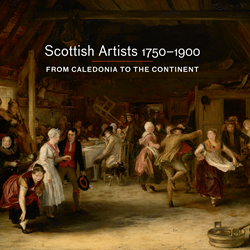
Scottish Artists
A collection of works by Scottish Artists collected by British monarchs from George III to the present day.
SIR DAVID WILKIE (1785-1841)
The Defence of Saragossa
Signed and dated 1828Oil on canvas | 94.2 x 141.5 cm (support, canvas/panel/str external) | RCIN 405091
The Edinburgh-trained artist David Wilkie settled in London in 1805 and soon won acclaim for his paintings, many of which used Romantic continental subject matter. In 1825 he visited France for the third time, at the start of a three-year visit which included an extended stay in Spain. His first-hand experiences are combined here with contemporary interest in the Spanish struggle for independence from Napoleon. The two-month siege of Saragossa in 1808, when the local guerrilla leader Don José de Palafox y Melci led heroic, ill-equipped citizens to victory, had been commemorated in poetry and prose, most notably by Byron in Childe Harold's Pilgrimage (canto I, 54-9). Here Agostina Zaragoza (the 'Maid of Saragossa') lights the fuse in the cannon which Palafox, dressed as a volunteer, directs with Father Consolaçion, an Augustinian friar.
Wilkie had planned the composition by 19 November 1827, the date on a preparatory study (Blackburn Museum and Art Gallery). Through Prince Dolgoruki of the Russian Legation at Madrid, Wilkie had sittings from Palafox himself, but letters as late as 15 April 1828 reveal that the painting remained unfinished. The success of Wilkie's early genre and history paintings, much influenced by seventeenth-century Dutch and Flemish artists, now gives way to a bolder style redolent of his careful study of Correggio, Titian and Rubens, and of Velázquez and Murillo in Spain. On his return journey from Spain, Wilkie met the French history painter Delacroix whose famous Liberty Leading the People (1830; Paris, Louvre) takes up many of the themes of this painting.
George IV acquired six paintings (including this one) from Wilkie following his return to London. The King's collection already contained two paintings by Wilkie, who had served as King's Limner in Scotland since 1823. Away from London for three years, and painting in a new style, such generous support came at a crucial moment in Wilkie's career and confirmed his reputation in the eyes of the British public. In 1830 he succeeded Lawrence as Principal Painter to the King; he continued to serve William IV and the young Queen Victoria in this capacity.
Catalogue entry from Royal Treasures, A Golden Jubilee Celebration, London 2002
Wilkie had planned the composition by 19 November 1827, the date on a preparatory study (Blackburn Museum and Art Gallery). Through Prince Dolgoruki of the Russian Legation at Madrid, Wilkie had sittings from Palafox himself, but letters as late as 15 April 1828 reveal that the painting remained unfinished. The success of Wilkie's early genre and history paintings, much influenced by seventeenth-century Dutch and Flemish artists, now gives way to a bolder style redolent of his careful study of Correggio, Titian and Rubens, and of Velázquez and Murillo in Spain. On his return journey from Spain, Wilkie met the French history painter Delacroix whose famous Liberty Leading the People (1830; Paris, Louvre) takes up many of the themes of this painting.
George IV acquired six paintings (including this one) from Wilkie following his return to London. The King's collection already contained two paintings by Wilkie, who had served as King's Limner in Scotland since 1823. Away from London for three years, and painting in a new style, such generous support came at a crucial moment in Wilkie's career and confirmed his reputation in the eyes of the British public. In 1830 he succeeded Lawrence as Principal Painter to the King; he continued to serve William IV and the young Queen Victoria in this capacity.
Catalogue entry from Royal Treasures, A Golden Jubilee Celebration, London 2002







